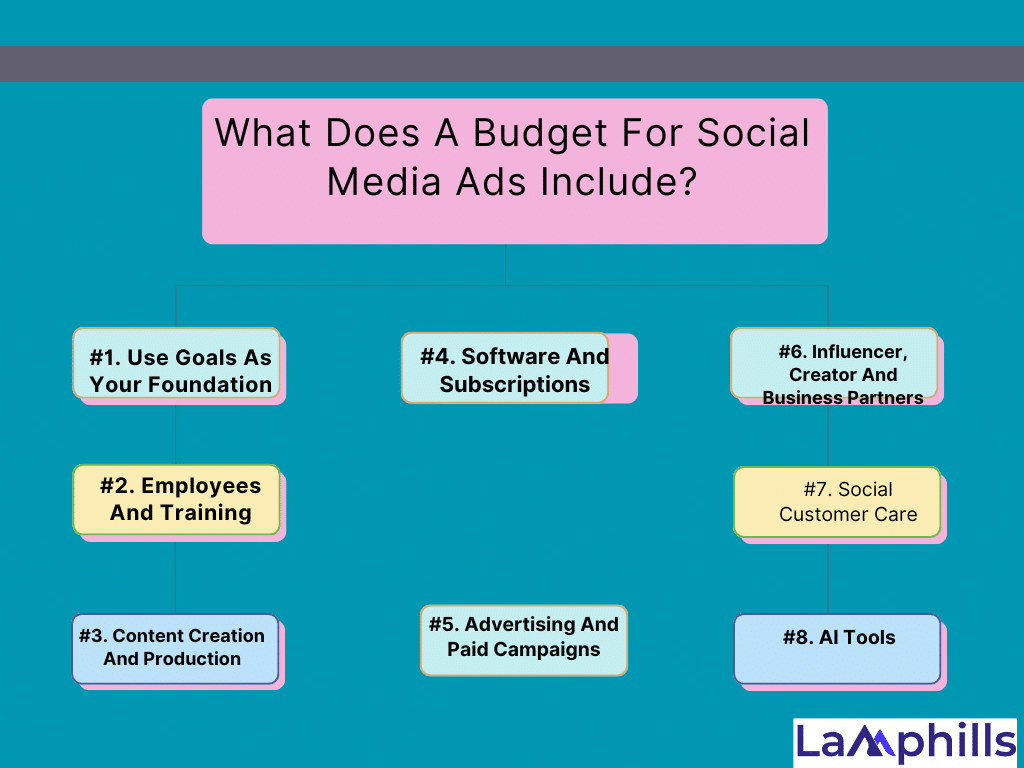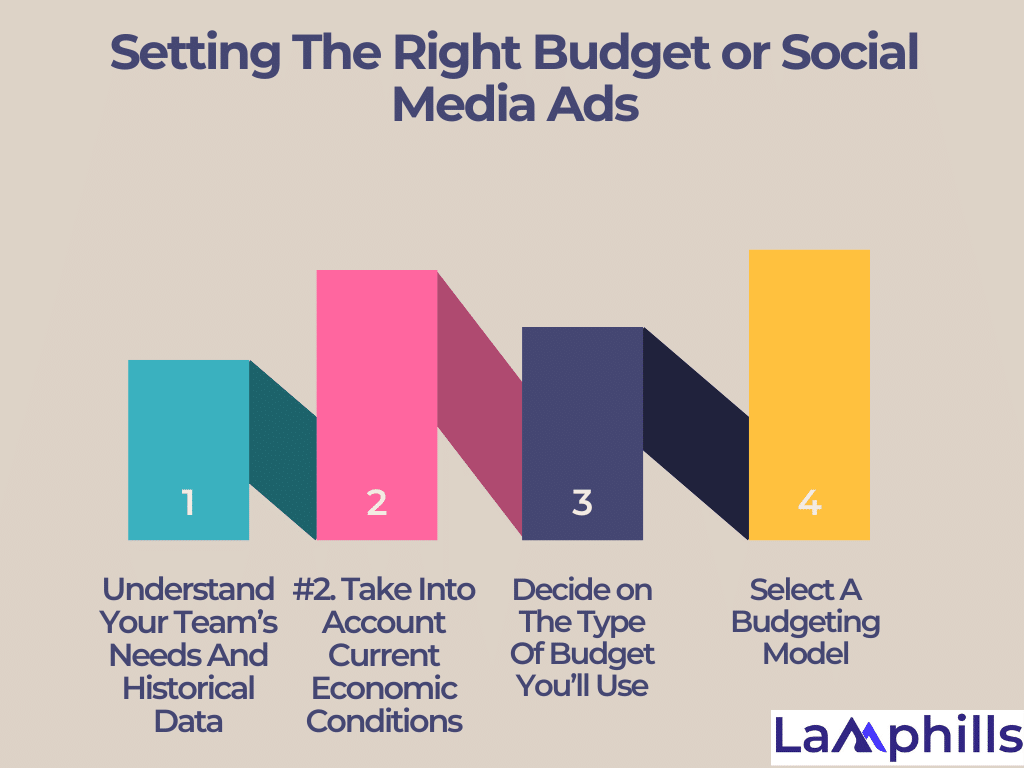Social media ads have transformed the way businesses reach out to their ideal customers and increase sales. But, as thrilling as it sounds, crossing the waters of targeting and budgeting can be difficult, even for seasoned marketers. As a content writer who has spent numerous years figuring out the complexity of social media campaigns, I understand the frustrations that come with wasting ad dollars or struggling to reach the correct audience. To help you, let’s look at how you can master the art of targeting and budgeting for social media ads to ensure your hard-earned money doesn’t go to waste.
Key Takeaways
- Effective social media ad targeting ensures that your ads reach those who are most likely to engage with your brand, making each dollar spent more impactful. Utilizing options like demographic, interest-based, custom audiences, and lookalike audiences can significantly improve campaign success.
- Custom audiences allow you to leverage your existing customer data for retargeting, while lookalike audiences help expand your reach by targeting users similar to your best customers, making it a powerful strategy for scaling campaigns.
- To maximize your social media ad spend, align your budget with clear goals, whether it’s driving conversions, building awareness, or retaining customers. A well-defined strategy helps allocate resources effectively.
- High-quality, engaging content, especially short-form videos, is vital for social media success. Allocating a budget for content production, including video editing and graphic design, ensures that your ads remain compelling and competitive.
- Integrating AI tools in your social media strategy can streamline processes like data analysis, customer support, and ad optimization, allowing your team to focus on creative and strategic tasks for better results.
What is Social Media Ads For Targeting?

Social media ads are a form of digital advertising. It simply implies investing money to reach your target audience via promoted content on a social media network. The number of individuals that see your social media ads is known as your “paid reach.” This is in contrast to your “organic reach,” which refers to the number of individuals who view your material as a result of social media algorithms. Different social media sites have different methods and criteria for displaying your advertisements.
You’ve designed a stunning, eye-catching advertisement that you’re convinced will resonate with people. However, rather than targeting people who are most likely to buy from you, your ad is shown to anyone. It’s like selling cold clothes on a tropical beach—very unsuccessful, right? That’s where targeting comes in. Social media ad targeting allows you to reach specific audiences based on factors like their demographics, interests, or behaviors. Think of it as a way to put your ads in front of people who are most likely to be interested in your product.
Examples of Ads on social media
Below are case studies of ads from renowned companies
#1. Dove
The brand has a history dating back to 2004, dedicated to promoting the concept of #realbeauty. Their most recent campaign highlights real women and goes by the name #ShowUs. In this campaign, they encouraged users to submit their images to enhance their representation in advertising. Presently, the campaign boasts a library containing over 5,000 photos, and the hashtag has garnered more than 650,000 uses.
#2. Snickers
Snickers used a clever strategy by utilizing its signature logo colors, featuring text in vibrant yellow set against a rich brown background, immediately drawing eye to the ad. It cleverly prompts users to share their “rookie mistake,” fostering engagement while offering a tempting incentive—a chance to win Superbowl tickets.
#3. Netflix: Global Rift Takeovers | Stranger Things 4
When Season Four of Stranger Things came out in the spring of 2022, it already had a huge fan base, so it didn’t need much extra promotion. However, Netflix decided to celebrate its worldwide popularity and its fans with a campaign called the “Global Rift Takeover.” This campaign featured impressive light shows, projections, and captivating visuals in cities like New York, Tokyo and Saudi Arabia, all in anticipation and excitement for Season four.
#4. Dollar Shave Club
While it’s in the business of selling razors and personal care products, Dollar Shave Club’s ads rarely focus on its products. A lot of its social posts are about self-care, self-improvement, and other helpful advice. It works because it’s helpful without selling or asking anything in return.
What Does A Budget For Social Media Ads Include?

Now that you know what to consider when developing your social media budget, you’re ready to dive into how to budget for social media marketing. Let’s break down some of the factors to consider as you do so.
#1. Use Goals As Your Foundation
You won’t know how to allocate your budget until you know your social media goals. For example, if you’re hoping for more conversions, you might invest more heavily into paid lead-generating campaigns and less into awareness efforts. To help you set goals, refer to your previous year’s goals and budget allocations. Ask yourself questions like:
- Did you meet those goals?
- Which strategies were successful?
- Did you have a budget left over or were you stretched thin?
- Do you want to increase resources to drive new strategies or expand previous ones?
In addition to your social goals, examine your audience’s motivations for following your brand on social media. Your aims must be consistent with those of your target audience; otherwise, the disconnect may result in low engagement.
Once you’ve decided on your goals, the next step is to consider all of the many components that go into a budget.
#2. Employees And Training
Social marketers are multi-dimensional. They frequently work on copywriting, data analysis, strategy, creative development, and other projects. These activities frequently support demands that extend beyond marketing. According to the Sprout Social Index Report, 76% of social marketers believe their team’s insights influence other departments, while 65% believe other teams influence their social efforts.
Businesses of all sizes should invest in recruiting, hiring, and retaining social marketers to succeed on social and protect their marketers from burning out.
Remember that adding more team members is not the sole option. There are instances when reorganization of existing team members may do the job. The majority of social teams are structured by the network, while others are structured by audience engagement, content distribution, and internal functional support. Consider what structure may work best for your team. No matter how big your team is, training will always be part of your budget. If you don’t learn or adjust to new features, you risk falling behind your competitors.
#3. Content Creation And Production
Social media has increased company competition, but creating unique, insightful content helps firms stand out in a competitive market. Consistent publishing and investment in material, particularly short-form video, is critical for attaining social objectives.
Creating content, whether in-house or outsourced, requires money, effort, and extensive planning. Video creation costs companies between $880 and $1200 per video; however, this varies by location. However, because video is the most popular content type for social media, you should incorporate it into your approach. Don’t forget about post-production—editing, audio, and graphic design require time and money. Don’t allow your material to fall flat because you failed to budget for post-production work.
Finally, if you’re going a paid content route, you’ll need to include that content creation here or in the general advertising budget.
#4. Software And Subscriptions
There are several manual activities that social media marketers must complete that might prevent them from prioritizing meaningful work with a greater impact. According to the 2024 Social Media Productivity Report, duties such as influencer management, customer service, and content development need a significant amount of time. Can these duties be entirely or partially automated, and can your team use the time saved to focus on other critical work?
Social media software can significantly improve the productivity of your social media department, allowing you to increase revenue and create a business impact. Many social teams employ resources with recurrent monthly or annual fees. They include subscriptions to social media management and analytics tools, as well as customer care and email platforms.
Whatever keeps your social marketing running smoothly should be included in this area of your budget.
#5. Advertising And Paid Campaigns
Advertising is another high-budget area for social media, and for good reason: 58% of customers say social media influences their shopping decisions. That is why many brands view paid social media as a critical component of their social media strategy.
For businesses running multichannel campaigns, you must decide how much to allocate to each channel. If Facebook is your main channel, it makes sense to spend more money there.
The average Facebook ad cost per click hovers around the $0.6 mark but fluctuates based on industry.
If you want to grow your Instagram audience, invest more of your social media campaign budget in Instagram ads. Thankfully, you can manage Instagram and Facebook ads from one location and even serve the same ad across both platforms. If you’re just starting with social media advertising, we suggest learning the basics first and experimenting with different platforms, targeting options, and content approaches.
#6. Influencer, Creator And Business Partners
Brands working with influencers they admire are cited by social media users as a motivator to buy. Brand collaborations, the thriving creator economy, and influencer marketing efforts all contribute to the prevalence of brand partnerships on social media. They efficiently improve your brand’s presence and attract new customers to your virtual door, but they are costly to execute, especially depending on your partner’s reach.
When it comes to dealing with content creators, marketers say budget is their biggest obstacle. For example, nearly half of all influencers charge between $250 and $1,000 for each post, which might be too expensive for some firms. Do your study and pick what channels and content types to prioritize early to make a better case for your creator-focused budget.
#7. Social Customer Care
Social networking has increased consumer interaction for brands: 63% of consumers believe that the level of customer care they receive on social media has a major impact on their brand loyalty.
Customers may use Social to express issues, ask questions, and seek assistance from brands in a quick, easy, and effective manner. This is why firms looking to differentiate themselves are investing in new customer service solutions on social. According to 71% of company leaders, most organizations now lack a clear social media strategy for customer support and care. This gap could represent a significant opportunity for your brand.
One of the major issues brands encounter when offering customer support on social media is that they are overwhelmed with customer requests and inquiries, making it difficult for them to resolve issues promptly.
#8. AI Tools
Artificial intelligence is changing the game for social media marketers, with the majority reporting a favorable influence on their business. AI-powered tools speed up almost every aspect of social media management, including data analysis, content development, and consumer engagement. If you want to help your social team enhance productivity for manual or repetitive work so they can focus on the human aspects of social media, adding AI solutions to your social media budget is essential. 61% of marketers testing with AI identify increased productivity as an immediate benefit, implying that the return on investment is also immediate.
How To Get Started With Social Media Ads

The hardest part of any marketing strategy is starting. But check off these basic steps, and you should have enough confidence to leap!
#1. Understand Your Audience
As with any marketing approach, you must first get a clear understanding of your intended audience. Use your existing customer data, conduct market research, and review analytics from existing platforms to get a sense of what might work effectively. This will assist you in determining who to target, what to target them with, and when. Then, once you’ve started running your advertisements and gathering data, you’ll be able to gain even more particular insights into who is viewing and engaging with them.
#2. Select One Channel To Start
A cross-channel marketing plan is crucial, but you must first learn the platforms before attempting to integrate them. The optimal channel will depend on your audience, but more often than not, Facebook is a good first step.
#3. Establish Some General Goals
What are you hoping to achieve with your social media ads? There’s no need to make traditional SMART goals here; it’ll be difficult to define particular measures until you get started. However, you can generally predict which campaign aim you’ll begin with based on your primary goal (awareness, lead generation, or conversions, for example).
#4. Look At Benchmarks
The amount you’ll pay for your social ads will vary depending on your industry, audience, optimization approach, and other factors, but it’s always a good idea to have a general point of reference before you start so you can make some budgetary expectations. You may get benchmark data here.
- Facebook advertising benchmarks
- Healthcare social advertising benchmarks
- Real estate social media advertising benchmarks
- Home services social media advertising benchmarks.
#5. Use Your Resources
There are plenty of free resources out there that can help you with social media advertising. We have a few roundups and even a tutorial for ya:
#6. Just start
If you’re a small business just looking to get your feet wet, your best bet is to just start and learn from there. Social media advertising platforms also take some time to learn as well, so the sooner you start advertising, the sooner you can start collecting the data the platform needs to start optimizing your ads.
Effective Tips For Social Media Ads
For social network advertising to work, you have to build up a social media advertising strategy. What will work best for each platform varies, but these general tips will help you to see success across platforms.
#1. Know Your Audience
An effective social media advertising campaign requires a thorough understanding of your target audience. Paid social media advertising, like any other sort of discussion, requires you to know who you’re speaking with. If you suggest ponies and unicorns in a business meeting discussing budgets, you’re unlikely to be well welcomed.
The same goes for discussing taxes and mortgages with preschool-aged children. To connect with your audience, speak their language. So, if you don’t know who your target audience is, prepare to do some research.
#2. Choose a Paid Advertising Campaign Goal
What is it that you want to accomplish with your paid social media ads? Without a clear idea, it’s hard to measure the success of your social ad campaign. Knowing exactly what you want out of your campaign will save you lots of time, money, and effort. Ive already outlined some social network ad goals above, but here’s a refresher plus a couple more of common social media advertising goals:
- Lead generation
- Traffic
- Visibility
- Engagement
- Brand affinity
- Sales
#3. Pick Your Social Media Platforms
This goes along with knowing your audience. Where do they like to hang out online? Once you figure that out, test out your ads on those platforms and regularly check how they perform.
Not all social media platforms may work for your brand, even if you can find your audience there. Take into consideration the possible benefits of each social platform when choosing which one to stick with. Ask yourself:
- Does the overall demographics of this platform match my brand?
- Does my audience regularly engage on this platform?
- Does my ad format (carousel, video, story, etc.) match this platform?
- Am I performing well on this platform organically?
- Are my competitors on this platform?
#4. Blend Social Media Ads With Content
If you want to advertise on social media, you most likely already have an organic social plan in place. If this is the case, use your organic results to guide your paid plan. You’ll gain a lot of insights from your ad data over time, but for now, look at audience insights, top-performing posts, low-performing articles, and engagement metrics to get a sense of the best audience categories to target and offers to promote.
Now you may begin planning your campaign. In an advertising campaign, you must use content that your target audience would enjoy. So, what content do you want to promote? Your social media campaign should consist of both organic content and sponsored marketing.
In other words, your social media campaign shouldn’t be separated into two distinct categories: paid and organic. Think about how your organic content can blend with your paid content, and vice versa. The way to keep them tied together is to have a theme for your ads and posts—a theme that moves people to action.
#5. Keep Mobile In Mind
This certainly goes without saying, but it’s worth repeating: keep mobility in mind. Most social media networks are accessed primarily via mobile (others are mobile-only). Of course, if you meet the picture specifications, your ads will automatically be formatted for mobile. However, keep a mobile attitude in mind while deciding what deals to promote and how to deliver your ads.
For example, if your target audience consists of young city-dwelling professionals, promoting a PDF guide on LinkedIn during morning commute time when they are using the network on their phones may not be appropriate. It may be more effective to run the ad when they are most likely to see it on their desktop.
#6. Measure Results — And Report On Them
Having specific data on the actual business value your advertising delivers to the firm (purchases, leads, and so on) is critical for showing (and improving) ROI. This will ensure that you have the funds you need to continue your task. The biggest social networks provide analytics to help you measure the effectiveness of your ads.
You may also utilize tools like Google Analytics and Hootsuite Advanced Analytics to monitor outcomes across several networks from a single dashboard. A social media report is an excellent tool to track your progress and find amazing content to promote through social ads.
Setting The Right Budget Or Social Media Ads

Setting a budget can feel like throwing darts in the dark. However, with a few guiding principles, you can create a budget that works for your business. Begin by considering your campaign goals. Do you want to raise awareness, drive traffic, or increase conversions? Each of these requires a unique budgeting strategy.
I once coordinated an ad campaign for a friend’s startup on a shoestring budget. We had to spend our money wisely. To grow an email list, we concentrated on ads that directed users to a lead magnet, such as a free downloading guide. The initial budget was modest, but the long-term benefits of nurturing those leads paid off. This experience taught me that your budget should align with your goals, even if you have limited resources.
#1. Understand Your Team’s Needs And Historical Data
Gather your previous social budgets, strategies, and performance data from the last two to three years. This is what you’re going to use to develop a baseline for your 2025 budget. In many cases, social marketers use their previous year’s budget as a starting point and increase or decrease it based on the company’s upcoming goals for social. This is a good way to begin, but it’s not the only data to use when developing your next year’s budget. Also consider:
- Organizational goals
- Past performance
- Social platform distribution
- Internal skills and expertise
#2. Take Into Account Current Economic Conditions
Marketers are always asked to do more with less—and you may be asked to do the same with your 2025 social media marketing budget. When determining how much to spend on social in the coming year, factor in the following macroeconomic conditions as they may affect your organization’s purse strings:
- Economic outlook:
- Industry trends:
- Competitive landscape
#3. Decide on The Type Of Budget You’ll Use
How will you determine your social media management costs based on the insights you’ve gathered? There are three common types of social media budgets:
- Traditional budget: This is where you start with a sum of money and then allocate amounts to each category. Once a category is depleted, you can’t move other funds into it. This type of budgeting requires careful and detailed projections for each type of expenditure. If you miscalculate how much you need for training, for example, your team may be out of luck until the next fiscal year—which may impact your social performance.
- Flexible budget: This is where category depletion can be fulfilled by another category. Did one run out of money and another category have extra to spare? Move it over. In this type of budget, you essentially have one pot of money, and you can allocate funds to different categories as needed. It’s a good option for brands that have shifting priorities during the fiscal year.
- Zero budget: This is when you start every category with zero at the beginning of each budget planning cycle. You increase the amounts per category, justifying the cost every time. One of the advantages of this type of budget is that each dollar spent is aligned closely with marketing and organizational goals. It’s a good way to keep your department on track if you have a history of straying from objectives.
#4. Select A Budgeting Model
Daily vs. Lifetime Budgets: A daily budget is the amount you’re willing to spend on advertising each day. It’s ideal for long-term initiatives that require daily cost control. In contrast, a lifetime budget establishes the total amount for the duration of the campaign. I’ve found lifetime budgets handy for short-term promotions, such as a holiday sale.
CPC (cost per click) vs. CPM (cost per impression) If you want to increase traffic to your website, CPC may be the way to go because you only pay when someone clicks your ad. However, if you want to get your brand in front of more people, paying per 1,000 impressions (CPM) may be more beneficial. When I was launching a brand awareness campaign, I chose CPM to help us reach a broader audience without worrying about individual clicks.
Cost per conversion: This strategy is great if you want to encourage specific activities, such as a purchase or sign-up. For one of my e-commerce clients, we concentrated on cost-per-conversion advertising and optimized it till the cost per transaction was tolerable. This allowed us to keep costs down while producing high-quality products.
There are several approaches to managing a marketing budget. Some teams even accept a lump sum and deduct as they go. If you have several components to track, it becomes more difficult to see how well your budget performs over time.
Conclusion
Targeting and budgeting for social media ads does not have to be difficult. With a defined strategy and a willingness to adjust your approach based on evidence, you can ensure that every dollar works hard for you. Remember that it’s not enough to reach people; you also need to reach the appropriate ones. Happy advertising, and may your next campaign generate more clicks, conversions, and customers!
At the end of the day, a budget allows you to structure your team and plan. It provides advantages that go beyond just boosting posts—from safeguarding the software you employ to driving your advertising strategy, powering sponsored partnerships, and more.
Whether you have a good idea of what your social media budget will be or are just getting started on your research, it helps to know how much time your team spends on each social task. Download this free time tracker template to get a clear picture of how long it takes to complete routine social tasks, so you can advocate for the resources you need to accomplish your goals.






